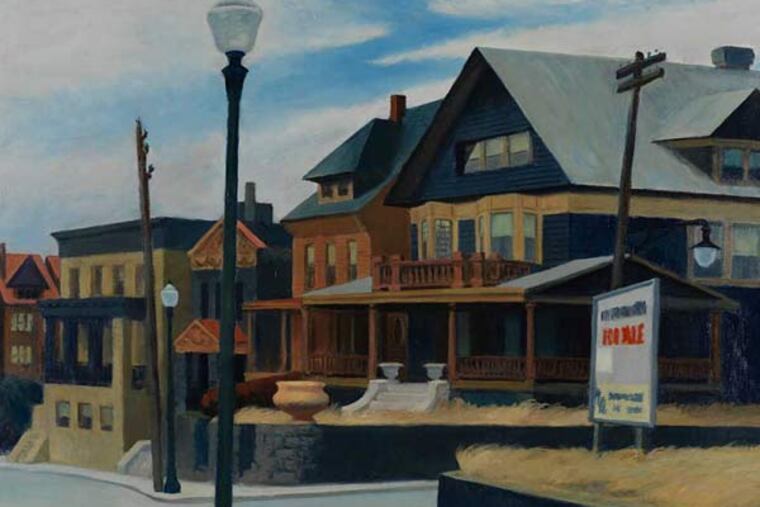Pennsylvania Academy to sell Hopper painting
The Pennsylvania Academy of the Fine Arts, owner of two signature oil paintings by American realist Edward Hopper, intends to sell one and plow the expected sizable proceeds into a fund largely for acquisition of contemporary art, officials have announced.

The Pennsylvania Academy of the Fine Arts, owner of two signature oil paintings by American realist Edward Hopper, intends to sell one and plow the expected sizable proceeds into a fund largely for acquisition of contemporary art, officials have announced.
The 1934 work, East Wind Over Weehawken, is a characteristically bleak streetscape, this one in North Jersey, of angular Victorian houses, tilted telephone and light poles, and almost insignificant figures; a prominent sign stands in the foreground, "For Sale" scrawled in vivid red across its face.
The academy purchased Weehawken directly from Hopper's dealer in 1952. It has been shown at PAFA many times and has been included in major Hopper exhibitions elsewhere, most recently a touring European retrospective that closed this year in Paris.
The academy owns the only oil paintings by Hopper in Philadelphia. (The other is Apartment Houses, from 1923.) The artist was not prolific, producing only about 360 paintings in his career. He died in 1967 at 84.
Weehawken will be sold by Christie's auction house in a December sale to "try to achieve maximum value" for the painting, said Harry Philbrick, director of the academy's museum. Christie's estimates the work will fetch $22 million to $28 million. Prices of the occasional Hoppers entering the market have soared in recent years. Actor and collector Steve Martin sold Hotel Window at auction in 2006 for $26.9 million, a record for Hopper.
Christie's auctioned his Blackwell's Island, a river scene, for $19.1 million in May. The Crystal Bridges Museum in Arkansas, backed by Alice Walton, this week acknowledged buying the work. It is unlikely, however, that a public institution will be able to afford the academy's Hopper.
Sales of artworks by museums have been fraught with controversy in recent years. In 2009, Brandeis University announced it would sell the contents of its Rose Art Museum to stabilize university finances. Lawsuits and public pressure killed the plan.
In 2007, Buffalo's Albright-Knox Art Gallery ignited a firestorm of criticism with its decision to sell older works in order to focus on contemporary acquisitions.
And the academy itself has generated controversy. In 2007, in the euphoric wake of acquiring Thomas Eakins' The Gross Clinic with the Art Museum, after the painting had been put on the block by Thomas Jefferson University, the academy sold another Eakins masterpiece, The Cello Player, to pay for its share of the deal. That work is now privately owned.
In 2010, the academy sold many works, including paintings by William Merritt Chase, Maurice Prendergast, Childe Hassam, John H. Twachtman, Frank Weston Benson, Arthur Carles, and others in order to fund acquisitions of contemporary art, Hudson River School art, and 20th-century work.
Now it's selling a major Hopper, a decision Philbrick called "difficult" but necessary to pursue what officials contend is a core museum mission - "to be actively engaged in buying the art of our time."
The academy, founded in 1805, is the nation's oldest museum and art school. Its past purchases often entered the collection not simply as art for the public, but as teaching tools for students.
The Hopper was chosen for a few simple reasons, Philbrick said. First, Hopper prices are rising fast in the marketplace. Also, the academy acquired the painting with its own money; no donor restrictions govern its disposition.
"We very actively collected contemporary art from the early 19th century to the middle of the 20th century," Philbrick said. "This move is an attempt to build a firm foundation to be actively engaged again in buying the art of our time."
Philbrick said a curator would be hired to oversee acquisitions from the endowment established by the sale, and two board members knowledgeable in contemporary art would be added to the trustees' acquisitions committee to assist in buying decisions.
He acknowledged that acquisitions of contemporary art are "a crapshoot" - today's genius more often than not is forgotten tomorrow. But it is worth the risk, he said.
"The pain of selling the work is immediately apparent," he said. "The gain won't be apparent until 50 or 60 years from now."
Philbrick likened the process to the academy's purchase of Winslow Homer's 1893 masterwork The Fox Hunt, acquired in 1894 after it appeared in the academy's prestigious annual show. In fact the academy's other Hopper, Apartment Houses, was also acquired, in 1925, after it appeared in that annual show. It was the first oil painting Hopper sold to a museum.
Both the Homer and the Hopper paintings were acquired for a pittance, although exact figures are not immediately available.
Those annual shows stopped in the early 1960s. When they stopped, the acquisitions stopped with them.
"If we don't purchase anything, we're not going to get it right at all," Philbrick said. "We're giving ourselves opportunity."